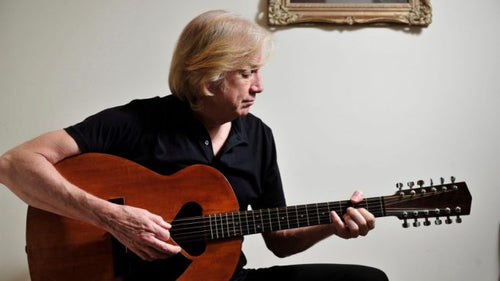
Justin Hayward comes to Morristown August 30
WHO: An Intimate Evening With Justin Hayward.
WHEN: 8 p.m. Sunday.
WHERE: Mayo Performing Arts Center, 100 South St., Morristown; 973-539-8008 or mayoarts.org.
HOW MUCH: $39 to $69.
So, let’s put “Nights in White Satin” in context.
It’s 1967, or maybe 1968. We’re at a Moody Blues concert. The lush, wine-purple strains of “Nights in White Satin” fill the theater. Brian Wilson, the genius of the Beach Boys, is sitting there looking mesmerized — inspired.
That brief moment from the this year’s biopic “Love & Mercy” sums up, in some ways, the whole period that produced “Nights in White Satin” — and so much other great music.
“It was very exciting,” says Justin Hayward, guitarist for the Moody Blues and writer of “Nights in White Satin,” who will revisit his long career Sunday during a performance at the Mayo Performing Arts Center in Morristown. “Though it didn’t last for long.”
The word may be “ferment.” Key for great years in rock — as for great years in wine.
Listeners, back then, were intoxicated with the possibilities of a new music that was pushing boundaries in all directions. And musicians themselves were competing with, and being inspired by, one another’s latest experiments.
“It was just about going to other people’s apartments, smoking a joint — for me — and sitting around and listening to music and sharing music, and people turning you on to interesting records,” Hayward says.
Bands became competitors and cheerleaders, excited by each other’s breakthroughs: The Beach Boys’ “Pet Sounds” was inspired by, and intended to top, the Beatles’ “Rubber Soul,” just as “Sgt. Pepper” was the Beatles’ answer to “Pet Sounds.” No surprise that Brian Wilson would have been turned on by the possibilities of “Days of Future Passed,” the experimental 1967 Moody Blues album that spawned the hit “Nights in White Satin.”
“There was just a change in the way people thought about music,” Hayward says. “I think there was a wave, in 1966 and early 1967, that swept through London and probably California and New York as well, and the part of the world where you are, New Jersey.”
“Nights in White Satin,” along with hits like “Forever Autumn” (which Hayward introduced on Jeff Wayne’s 1978 concept album “War of the Worlds”), “Watching and Waiting,” and material from the 2013 album “Spirits of the Western Sky” — his latest — will likely be part of the program as Hayward takes the stage in a pared-down trio setting. He’ll be joined by Mike Dawes on guitar, and Julie Ragins on keyboard: two backup players that are, themselves, worth the price of admission, he says modestly.
“If you’re interested in music and the brilliance of musicians — not me, but the two people I’m with — you’re going to have a great evening,” he says.
The bare-bones presentation of Sunday’s concert couldn’t be less like the mammoth roster of “Days of Future Passed” — which contained not only the entire lineup of the Moody Blues at the time (Hayward, Mike Pinder, Ray Thomas, John Lodge, Graeme Edge), but also “The London Festival Orchestra,” actually an ad-hoc ensemble of classical pickup players. “It certainly changed the way we thought about recording music,” he says.
And it was certainly a long way from where Moody Blues started: as a typical blues-based rock band, back in 1964.
Hayward wasn’t part of the group then. But no English musician, in those close-knit days, was more than a degree or two separated from any other. “It was a very small community in London in the mid-’60s,” he says. “Everybody kind of knew each other, from the Kinks to the Stones, right the way through.”
Which is how Hayward happened to answer a “musician wanted” ad in “Melody Maker” magazine in 1966 from none other than Eric Burdon of the Animals. Burdon passed — but he also passed the letter on to the Moody Blues, who were looking for a replacement for departing singer-guitarist Denny Laine.
With a new guitarist, a new bassist (Lodge), and a new keyboard instrument, the Mellotron, figuring prominently in the sound, the Moody Blues found itself changing musical direction. “We were pretty lousy at rhythm-and-blues,” Hayward says. “But what we were good at was having our own style, and our own distinctive kind of sounds to our songs.”
With a new guitarist, a new bassist (Lodge), and a new keyboard instrument, the Mellotron, figuring prominently in the sound, the Moody Blues found itself changing musical direction. “We were pretty lousy at rhythm-and-blues,” Hayward says. “But what we were good at was having our own style, and our own distinctive kind of sounds to our songs.”
This was precisely the time that rock-and-roll was expanded in exciting — and odd — new directions. The Moody Blues, by 1966, became something of a transitional band — halfway between the so-called “baroque” rock of bands like the Zombies (“She’s Not There”) and the arty 1970s “progressive” sound of Yes and Emerson, Lake & Palmer. “Even though we turn up in prog-rock magazines, I think we were well before that,” Hayward says.
One-upping the Beatles, who had used traditional instruments on tunes like “Eleanor Rigby” and “A Day in the Life,” “Days of Future Passed” was an epic concept album about an ordinary working day that — pioneeringly — used a symphony orchestra throughout as a key component of the sound. The sound itself was cutting-edge stereo, never before achieved in a rock-and-roll context.
“I think stereo, for pretty much every band, maybe with the exception of Brian Wilson, had been drums on the left, vocals on the right,” Hayward says. “A pretty poor version of stereo. I think we were pretty much the first group, thanks to Decca and their engineers and their quality, that saw stereo recording as the way forward.”
As a matter of fact, “Days of Future Passed” was originally conceived, by the suits at the record label, as a “stereo demonstration record” — that forgotten artifact of the 1960s, the LP that exists solely for you to show off your awesome new state-of-the-art hi-fi system. “It was only after it was out for a few months that [the label] thought, all right, people are actually buying this, not just to test out their stereo systems, but for something else,” Hayward says.
This quintessential FM album came out just as FM radio was starting to gain traction in America: it was in the States that The Moody Blues, who toured behind Canned Heat (where Brian Wilson would likely have seen them), really took off, and gained a popularity that eventually trickled back to England.
“We opened up for [Canned Heat], and they took us right across America, through the industrial heartland America that I knew nothing about as a kid,” Hayward says. “But I found out it was real Moody Blues country.”
The band wended its psychedelic way through the ’60s and ’70s with albums like “In Search of the Lost Chord,” “On the Threshold of a Dream,” and “Every Good Boy Deserves Favour.” There was a breakup — ahem, “extended break” — in 1974, and then a reunion in 1977. Meanwhile, the first of Hayward’s seven solo albums, “Songwriter,” appeared in 1977, and the following year he was featured on that cult, late-breaking “concept” album “War of the Worlds”: Martians invading to a rock beat. “It was a concept album that was kind of 10 years too late,” he says. “The passion for that kind of album had really passed. But it was a fascinating subject.”
By now, Hayward, the Moody Blues, and in particular “Days of Future Passed” is fully enshrined in the rock pantheon. Several years back, a Hard Rock amusement park opened in Myrtle Beach, S.C.: a “Nights in White Satin” dark ride was one of the 50 major attractions, right next to the Led Zeppelin “Whole Lotta Love” roller coaster.
One place the Moody Blues is not enshrined: the Rock and Roll Hall of Fame. Fans of the band remain incensed. But Hayward, like his most famous song, is mellow.
“I can’t say it impacts me in any way at all,” he says. “It means nothing in the U.K. Quite the opposite in fact. There’s a feeling in the U.K., ‘How dare they have a rock-and-roll hall of fame?’ But I do feel for the American Moody Blues fans.”
